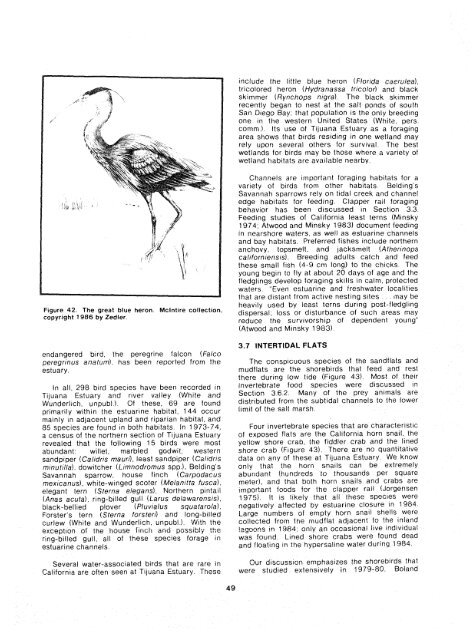The Ecology of Tijuana Estuary, California: An Estuarine Profile
The Ecology of Tijuana Estuary, California: An Estuarine Profile
The Ecology of Tijuana Estuary, California: An Estuarine Profile
You also want an ePaper? Increase the reach of your titles
YUMPU automatically turns print PDFs into web optimized ePapers that Google loves.
nciude the l~ttle blue heron (Flortda caerulea).<br />
tricolored heron (Hydranassa tricolor) and black<br />
sk~mmer (Rynchops nrgra) <strong>The</strong> black skimmer<br />
recently began to nest at the salt ponds <strong>of</strong> south<br />
San Drego Bay. that population is the only breeding<br />
one in the western United States (Whits, pers<br />
comrn Its use <strong>of</strong> Tiluana <strong>Estuary</strong> as a foraging<br />
area shows that brrds resrding in one wetland may<br />
rely upon several others for survival <strong>The</strong> best<br />
wetlands for birds may be those where a variety <strong>of</strong><br />
wetland habttats are available nearby<br />
Figure 42. <strong>The</strong> great blue heron Mclntrre collectton,<br />
capyright 1986 by Zedler<br />
endangered bird, the peregrine falcon (Faico<br />
peregrtnus anaturn). has been reported from the<br />
estuary<br />
In all, 298 bird species have been recorded in<br />
<strong>Tijuana</strong> <strong>Estuary</strong> and river valley (Whtte and<br />
Wunderlrch, unpubl) Of these, 69 are found<br />
prlrnarrly within the estuarine habitat, 144 occur<br />
mainly in adjacent upland and riparian habitat, and<br />
85 specres are found in both habitats In 1973-74,<br />
a census <strong>of</strong> the northern section <strong>of</strong> <strong>Tijuana</strong> <strong>Estuary</strong><br />
revealed that the following 15 birds were most<br />
abundant willet, marbled godwit, western<br />
sandp~per (Cal[drls rnauri), least sandpiper (Cal~drrs<br />
rntnutrtla), dow~tcher (Lfrnnodromus spp 1. Belding's<br />
Savannah sparrow, house finch (Carpodacus<br />
rnexfcanus), white-w~nged scoter IMelan/tta fusca).<br />
f legant tern (Sterna elegans), Northern pintall<br />
(<strong>An</strong>as acuta) ring-billed gull (Larus delawarensfs),<br />
black-bellied plover (Pluv~alus squalarola).<br />
Forster's tern (Sterna forsterd and long-billed<br />
curlew (Whrte and Wunderllch, unpubt ) With the<br />
exception <strong>of</strong> the house ftricil an3 possibty the<br />
ring-brlled guli, ali <strong>of</strong> these species forage tn<br />
estuar!ne channels<br />
Several water-assoc~ated birds that are rare tn<br />
Californra are <strong>of</strong>ten seen at Ti~uana <strong>Estuary</strong> <strong>The</strong>se<br />
Channels are ~mportant foraging habitats for a<br />
var~ety <strong>of</strong> b~rds from other habitats Beld~ng's<br />
Savannah sparrows rely on tidal creek and channel<br />
edge habitats for feeding Clapper rail foraging<br />
behavior has been discussed In Section 3 3<br />
Feeding studies <strong>of</strong> <strong>California</strong> least terns (Minsky<br />
1974, Atwood and Minsky 1983) document feeding<br />
rn nearshore waters, as well as estuarine channels<br />
and bay habitats Preferred ftshes include northern<br />
anchovy, topsmelt, and jacksmelt (Ather~nops<br />
calrforn~ens/s) Brecdrng adults catch and feed<br />
these small ftsh (4-9 cm long) to the chicks <strong>The</strong><br />
young begin to fly at about 20 days <strong>of</strong> age and the<br />
fledgl~ngs devciop faraging skills in calm. protected<br />
waters "Even estuar~ne and freshwater IocaliEies<br />
that are d~stant from active nesting sltes liiay be<br />
heav~ly used by least terns during post-fledgling<br />
dispersal, loss or disturbance <strong>of</strong> such areas may<br />
reduce the survrvorshtp <strong>of</strong> dependent young"<br />
(Atwood and Minsky 1983)<br />
3.7 INTERTIDAL FLATS<br />
<strong>The</strong> conspicuous species <strong>of</strong> the sandflats and<br />
mudflats are the shorebirds that feed and rest<br />
there during low tide (Figure 43) Most <strong>of</strong> their<br />
invertebrate food species were discussed in<br />
Section 362<br />
Many <strong>of</strong> the prey animals are<br />
distributed from the subtidal channels to the lower<br />
llmrt <strong>of</strong> the sait marsh<br />
Four invertebrate species that are characteristic<br />
<strong>of</strong> exposed flats are the <strong>California</strong> horn snalt, the<br />
yellow shore crab, the ftddier crab and the lined<br />
shore crab (Figure 43) <strong>The</strong>re are no quantitative<br />
data on any <strong>of</strong> these at <strong>Tijuana</strong> <strong>Estuary</strong> We know<br />
only that the horn snails can be extremely<br />
abundant (hundreds to thousands per square<br />
meter), and that both horn snails and crabs are<br />
rmportant foods for the clapper rail (Jorgensen<br />
1975) It IS l~keiy that all these species were<br />
negatively affected by estuarine closure rn 1984<br />
Lafge numbers <strong>of</strong> empty horn snail shells were<br />
collected from the mudfiat adjacent to the ~niand<br />
!agoom in 1984 only an accastonai Itve ~ndtvidual<br />
was found Lined shore crabs were found dead<br />
and floating in the hypersaline water durtng 1984<br />
Our discussron emphasrzes the shorebrrds that<br />
were studred extensively in 1979-80. Boland

















